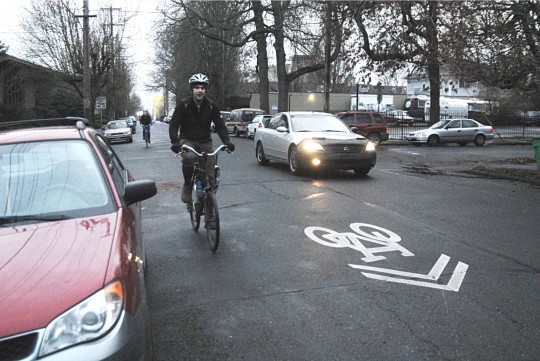
(Photo: M.Andersen/BikePortland)
After about a year on hold, proposed improvements to a much-used neighborhood greenway are back in action.
City project manager Sheila Parrott will meet March 10 with the Buckman Neighborhood Association to discuss the need for speed bumps and a new traffic diverter to reduce auto speeds and volumes in inner SE Ankeny Street.
“Much like Clinton, we kind of know we’re going to be looking at diversion, but there’s still a lot of conversation that needs to happen: where and what and how.”
— Margi Bradway, PBOT Active Transportation Division Manager
As we reported in late 2014, the city began discussing a diverter at Ankeny and 15th, near the Imago Dei church, after activist group BikeLoudPDX called for one and the Buckman Community Association tentatively backed them up.
Early last year, that plan was put on ice until after the city could complete a full study of traffic speeds and volumes on its 70-mile neighborhood greenway network. That study, which was unanimously endorsed by the city council, named Ankeny as one of the top six candidates for improvement.
Ankeny draws more than 2,000 autos per day on its innermost stretch, west of SE 7th Avenue. Between SE 28th and 15th, it’s common for autos to move at 26 to 30 mph. That’s 6 to 10 mph over the speed limit.
The “Burnside Corridor Bikeway,” which runs on Ankeny, Couch, Davis and Everett, is the city’s third-most biked greenway, after Lincoln-Harrison and Clinton-Woodward.
On parts of the corridor, bike traffic outnumbers auto traffic. Ankeny carries 2,115 bike trips per day at 28th, the city says.
City hires new project manager to specialize in small projects like this
Portland Active Transportation Manager Margi Bradway said in an interview Monday that the Ankeny project will draw on last year’s process for improving Clinton Street, where two trial diverters are now in place.
“Much like Clinton, we kind of know we’re going to be looking at diversion, but there’s still a lot of conversation that needs to happen: where and what and how,” Bradway said. “This is the next one in line. And for each of these, we promised City Council that we would implement the recommended neighborhood greenway report, but we also promised city council that each neighborhood association would have an opportunity to weigh in on the design.”
Bradway said the “draft proposal” would add the diverter at 15th, but she added that its location and design is flexible — the goal is to reduce auto volumes and speeds one way or another.
Advertisement
Bradway added that she’s excited to welcome Parrott to her team. The city’s new project manager, who has a civil engineering degree, is a recent hire from Eureka, Calif., where she specialized in building the biking network.
In Portland, Parrott will work on relatively quick, low-cost biking and walking improvements that will be installed by in-house workers.
That’s in contrast to recent projects such as the Clinton Street improvements. To get that project done, Bradway needed to secure time and buy-in from people in another unit, the city’s “capital projects” team.
“We needed someone solely focused on these smaller projects to get them out the door, and our capital projects group is really busy,” Bradway explained.
Parrott will be part of the active transportation group and report to Bradway. In the 2016-2017 budget, the group is lined up for an allowance bump of at least $200,000 per year of installation dollars for improvements to streets like Ankeny.
According to Bradway, the installation cost of a single permanent diverter comes to about $30,000. “Diverters are pretty cheap,” she said.
If you’re interested in supporting this project and want to get involved, BikeLoud has already organized a “Safer Ankeny Subgroup” and is planning a meeting on the subject this Saturday at noon at the 28th/Ankeny food carts. (Or the Crema coffee shop in case of bad weather.)
— Michael Andersen, (503) 333-7824 – michael@bikeportland.org
BikePortland can’t survive without paid subscribers. Please sign up today.
Correction 11 am: A previous version of this post inaccurately said speed bumps had already been installed on Clinton Street.


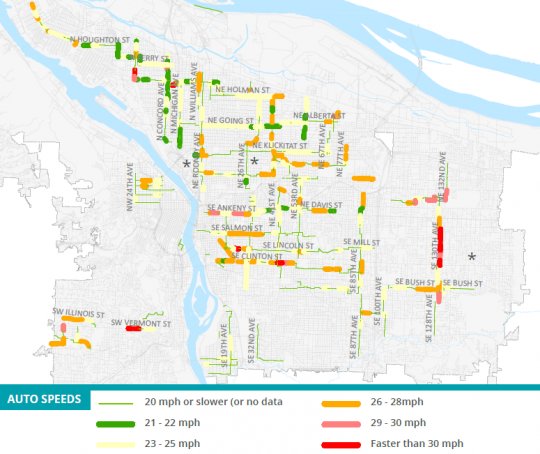
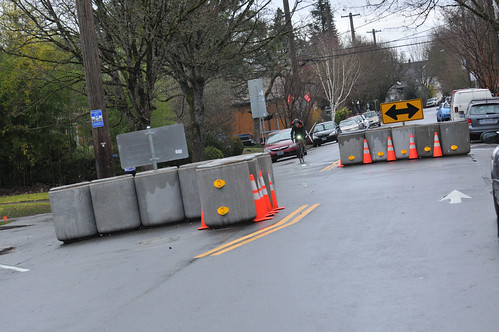

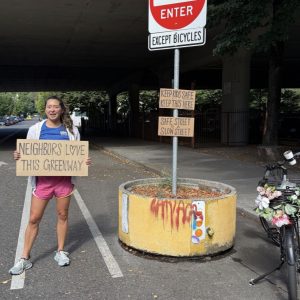
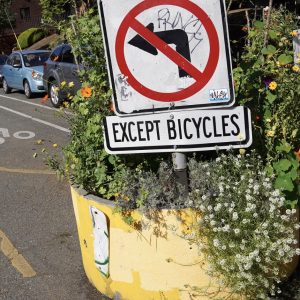
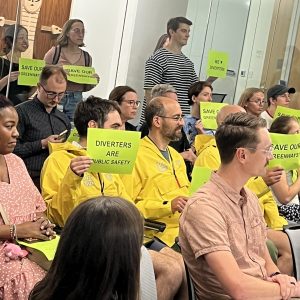
Thanks for reading.
BikePortland has served this community with independent community journalism since 2005. We rely on subscriptions from readers like you to survive. Your financial support is vital in keeping this valuable resource alive and well.
Please subscribe today to strengthen and expand our work.
The speed bumps on Clinton were never installed, FYI. I have my doubts about their effectiveness anyway. Anecdotally, drivers seem to drive over them at speed, since modern cars now all have decent suspensions. Plus, they create more obstacles for people cycling and in some cases even result in spilt beer! (I know this from personal experience, unfortunately)
Good to see the city is getting serious about fixing our greenways quicker. The Clinton process, while a step in the right direction, dragged on far longer than it needed to. Looking forward to a more agile approach!
Thanks, Adam. I’ll correct.
The bumps east of Chavez go in when the weather warms up this year. PBOT needs several days of dry weather, typically above 60 degrees, for longer lasting speed bumps, otherwise the thin edges unravel too easily.
Adam,
The average speed at a 14-ft speed bump, without consideration of spacing, is 20 mph. The highest recorded was 24 mph and lowest recorded was 16 mph.
Good to know, thanks!
I think speed bumps are more effective in pairs. If the car hits the second bump when its suspension is compressed from the first bump, the driver gets a bigger jolt.
BikeLoudPDX is holding a meeting this Sat to plan support for improvements on the Ankeny Neighborhood Greenway and cross streets (e.g. 28th).
The meeting will be held Saturday March 5th at 12 pm at the 28th and Ankeny food carts (with Crema bakery being the alternate location for bad weather).
https://www.facebook.com/bikeloud/photos/a.612814802160738.1073741829.600426656732886/848933775215505/?type=3&theater
To really improve ANkeny, PBOT should consider extending the 11th/12th couplet to Couch. This would make 11th one-way from Couch. The 11th/Sandy/Ankeny intersection would become signalized, and Sandy would become on-way NW-bound.
Finally, add a signal at Ankeny and MLK.
This diverter seems ok, too- start with that.
The city rebuilt that intersection less than 5 years ago. While we can all wish they took active transportation into higher consideration, they didn’t, and I really doubt they will redesign the and extend better access to southbound 12th anytime soon. Sad but true.
As previously stated, the pending project is only considering Ankeny, 12th to 28th.
Max,
mistype? Sandy goes from SW to NE, so you can’t be NWbound on Sandy.
Then there is the question of why one way on Sandy?
If anything the segment of Sandy from 11th to 12th should be eliminated, but then you need a new path for people going northeast (or SW) no Sandy.
Having a signal with entering traffic from three directions makes the control very complicated, and not that efficient.
A compact modern roundabout would fit in the area.
Oops, I meant NE! I think one-way NE to avoid using Ankeny as a “square- about” for cars. I agree the 3-way intersection is complicated but I still think it is a big improvement over the uncontrolled mess we have now.
I love the roundabout idea, great suggestion!
“Between SE 28th and 15th” Cars can’t travel from 28th to 15th
I support motor vehicle diversion on/from Ankeny as long it’s put in a spot that doesn’t then create a necessity for cars to make a left hand turn onto Burnside wb, or to cross Burnside from south to north, at any uncontrolled intersections. (Or require a circuitous travel route through the Buckman neighborhood to escape it)
Both of those outcomes are unacceptable and create a hazard by encouraging unsafe driver behavior due to traffic volumes on Burnside.
So… given that the only Burnside intersection between 15th & 28th that is controlled for cross motor vehicle traffic (20th) already has diversion, would you support more diversion on Ankeny?
Also – why is it OK to have bike routes cross major streets without a light (e.g. Ankeny at 20th, Ankeny at 28th, 42nd at Division) but not OK to cause some motor vehicle operators to need to cross or turn at major streets without a light (at least until they learn where the diverters are)?
Oliver,
sounds like a sabot in the works. The point of making streets less desirable to drive on is…
making them less desirable to drive on.
Anyone driven across Clinton at these intersections? It is completely blind in a passenger car. I love the diversion and the reduced throughput on Clinton. It would be nice to install diversion devices that do not obstruct the view of cross traffic.
Or just enforce the law that bans parking next to an intersection. It’s already on the books.
Yes, please.
Spencer,
‘completely blind’. At a stop sign? Parking was removed on Clinton at 32nd and on 17th at Clinton.
Is it really the cars blinding you, or maybe the trees are part of the issue.
The island at 17th can’t be an issue, and the planters at 32nd are temporary. A permanent solution will be much lower to the ground.
I ride Ankeny daily and see that a lot of the cut through traffic (and a lot of the silly passing/speeding) is done by Central Catholic kids/staff, because between 39th and 20th they all have a CC on the back of the cars.
Diverters would be appreciated but perhaps working with the school would also be helpful.
Below 20th the cut through traffic and speeders are those that want to avoid the couplet. Which is often pretty backed up.
Heading west, I have mostly stop riding the Burnside bike lane as Ankeny is so much more pleasant and safe (until Sandy). The crossing at Sandy needs to be addressed as it is not safe. The green box next to the island seems really awkward to use.
I second all the drivers avoiding the couplet. Why’d they put a signal every block on that thing? You are crawling along at 11 miles westbound down that darn stretch. It’s no wonder car drivers take Ankeny where they can do 30!
Which is it, make it more difficult to drive, or don’t make it more difficult to drive?
lahar, one of the things we will discuss this Sat is what can be done to mitigate conflict at 12th.
and in that terrible stretch between 6th and 12th.
Yes!!!!!!!
“Bradway added that she’s excited to welcome Parrott to her team. The city’s new project manager, who has a civil engineering degree, is a recent hire from Eureka, Calif., where she specialized in building the biking network.”
I ride through Eureka once or twice each year. Most of its bike infrastructure is relatively new. It is also horrific. I know many Portland riders are content to ride in door zones, but dooring is the most common cause of injuries and deaths to cyclists in San Francisco (a rare place that collects data on this). Chicago found that dooring accounts for 23% of its cycling injuries a few years back. Most every bike lane in Eureka is of the fully in the door zone variety. If Parrott had anything to do with Eureka’s non-network for cycling, she’s got a lot to answer for.
Let’s hope she has learned something from riding a bike through that? Props to PBOT for working toward a fast-and-light (like a bike) structure that can get cheap things done quickly to make biking more comfortable. Every dollar they put into that will turn into at least two.
The biggest problem in Eureka is Highway 101, and Caltrans gives the City no ability to make changes on it.
I have worked with Sheila and I think she’s a terrific hire for this position. She’s smart, dedicated, and capable. I like that PBOT saw the need for a small projects manager to get things done quicker, and then they created it.
HM….I’ m happy they say thery are flexible in the design as we need more Diversion, period. North Tabor, further east on the “Burnside corridor,” has called unanimously for multiple diversion locations. If we concentrated on the whole corridor, which is the only “built ” Bikeway between Mount Tabor and Rocky Butte we could really create a high end greenway with PREDICTABLE Diversion at or near every arterial crossing from 80th all four miles west to the bridge. Safe, predictable, community supported.
However, that would require global foreward thinking and a real vision, not just triage. Oh yes, Sharrows from 32nd to 41st would be helpful as well.
Speaking as the North Tabor NA Transportation and Land Use Chair and one who could ride Ankeny blind…… I’m pretty sure.
So, diverters instead of speed humps? That’s my preference — if drivers can cut through, they will. Speed humps will slow down some drivers a bit, but I don’t want to ride a bike over them. Also, speed bumps tend to put cars in the way where getting rid of the auto traffic makes it safer, faster, and easier to bike through.
Maybe put the speed bumps in chokers with bike-only bypasses around the outsides. Would need to take some space away from parking and make the choker lane close to 8ft wide. (Don’t let PBOT tell you bus mirrors need extra curb width.)
You really need both. Speed humps control speed, diverters control volumes. Since there will always be some cars on the road for local access, you still need to control speeds.
Narrow curb widths also control speed and discourage unsafe passing. They also don’t interfere with cycling. However, we’d have to remove nearly all car parking for it to work, so it will never happen in Portland…
how narrow a street width are you talking about?
Ideally? 18 feet curb-to-curb, bi-directional, no on-street parking. No one will drive on it unless they absolutely have to, and drivers will have to pull over to allow other drivers to pass.
18 feet curb to curb does not require people to pull over to pass opposing each other, unless they are driving down the middle to begin with.
If they are driving down the middle to begin with, then their ‘lane’ is one way and 18 feet wide, and there is no deterrent to speed.
On what kind of streets would you implement such a standard (examples please).
BTW, most neighborhood collector streets in Portland are 36 feet wide with about 20 feet between parked cars for 2-way travel, and most people know of such streets where speeding occurs regularly.
18-foot streets can work if advisory bike lanes are used, so that the travel lane is narrowed to the width of a one-way. AFAIK, these are illegal in Oregon, so not sure how it could be implemented.
One example of a narrow street that works well is the block of Clinton between 49th and 50th, where it narrows to ~20 feet with no parking. Would be interesting to see how a Greenway would work if that block was extended for the entire length.
When a 16 month old project that’s already a year overdue has no tangible results, what’s another delay?
People get the government they deserve.